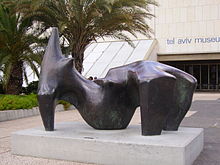| Reclining Figure 1969–70 | |
|---|---|
 in the
Lola Beer Ebner Sculpture Garden at the entrance of the
Tel Aviv Museum of Art. | |
| Artist | Henry Moore |
| Year | 1969 |
| Catalogue | LH 608 [1] |
| Type | Bronze |
| Dimensions | 343 cm (135 in) |
Reclining Figure 1969–70 (LH 608) is a bronze sculpture by English artist Henry Moore.
History
Inspired by the shape of a piece of flint, Moore created a maquette for the sculpture in plaster which was cast in an edition of small bronzes, some 15 centimetres (5.9 in) long. The maquette was used to create a full-size version in polystyrene, which was used to create a mould for a monumental sculpture.
The sculpture can be viewed as an abstraction of a reclining female human figure, resting on one arm, hip and two legs, with the second arm raised, and a prominence on the chest suggesting a breast. It has no evident face.
Six full-size copies were cast in 1969 and early 1970, at the Noack factory in Berlin, and an artist's copy was cast shortly before Moore's death in 1986. The sculpture measures 3 × 3.6 × 2 metres (9.8 × 11.8 × 6.6 ft) and weighs around 2 tonnes (2.2 tons). One cast was exhibited in a major retrospective of his work at the Forte di Belvedere in Florence in 1972, later described by Moore as the pinnacle of his career.
The artist's cast (0/6) was stolen from the Henry Moore Foundation at Perry Green, Hertfordshire on 15 December 2005. It is believed to have been hoisted onto the back of a stolen flatbed Mercedes lorry using a crane, cut up for scrap the same night, and shipped to Rotterdam, and then probably to the Far East. The sculpture was estimated to be worth £3m, but only £1,500 as scrap. The theft inspired German artist Fritz Balthaus in 2009 to cast bronze ingots of equivalent weight which, arranged in a form approximating Moore's sculpture, are displayed as Pure Moore at the Federal Criminal Police Office in Berlin. [2]
See also
- List of sculptures by Henry Moore
- List of heists in the United Kingdom
- Two-Piece Reclining Figure No. 9
- Two-Piece Reclining Figure: Points
References
- ^ "Reclining Figure". henry-moore.org. Archived from the original on 17 December 2022.
- ^ Maak, Niklas. "Glosse Feuilleton: Kunstzerstörer". Faz.net.
External links
- £3m Henry Moore sculpture stolen, BBC News, 17 December 2005
- Image, Henry Moor Foundation
- Mystery of the stolen Moore solved, The Observer, Sunday 17 May 2009
- Lost Art: Henry Moore, Tate Gallery, 6 August 2012
- Mystery of the stolen Moore solved, The Guardian, 17 May 2009
- Israel Public Art
- Louisiana Museum of Modern Art, Henry Moore Foundation
- Hakone Open-Air Museum, Henry Moore Foundation
- Tel Aviv Museum of Art, Henry Moore Foundation
- Art theft: some of the famous art heists of the last 100 years, The Telegraph
- Celebrating Moore: Works from the Collection of the Henry Moore Foundation, p. 39-40
- Gallery of Lost Art
